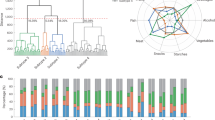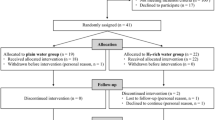Abstract
Background/Objectives:
We studied the relationship between socioeconomic status (SES), represented by household income, and the prevalence of anemia and iron deficiency anemia (IDA) among adolescent girls in Korea.
Subjects/Methods:
The samples were based on the data from a four-year (2008–2011) collection for the Korea National Health and Nutrition Examination Survey (1312 girls, age 10–18 years). The survey included demographic, anthropometric, biochemical and nutritional parameters. A multiple regression analysis after adjusting for age, body mass index (BMI), red blood cell count, white blood cell count and red meat intake was performed. Anemia was defined as hemoglobin level lower than 11.5 g/dl for ages 10–11 years and 12.0 g/dl for ages 12–14 years. Iron deficiency was defined as serum ferritin level below 15 μg/l.
Results:
The prevalences of anemia and IDA in Korean girls were 5.3 and 4.2%, respectively. Girls with anemia were older, taller, weighed more, had higher BMI, had higher portion of menarche experience and consumed less red meat than girls without anemia. Girls with higher income had lower anemia prevalence and consumed more iron and vitamins. Logistic regression analysis showed a decreasing trend in anemia prevalence as household income increased. Correlation analysis demonstrated that there is a relationship between household income and serum hemoglobin and ferritin levels (P=0.003 and P=0.026, respectively).
Conclusions:
Higher SES leads to lower prevalence of anemia and IDA in Korean adolescent girls. This may be due to the fact that higher SES individuals consume more iron and vitamin C.
This is a preview of subscription content, access via your institution
Access options
Subscribe to this journal
Receive 12 print issues and online access
$259.00 per year
only $21.58 per issue
Buy this article
- Purchase on Springer Link
- Instant access to full article PDF
Prices may be subject to local taxes which are calculated during checkout

Similar content being viewed by others
References
World Health Organization. Iron Deficiency Anaemia: Assessment, Prevention And Control. A guide for programme managers. WHO: Geneva, 2001.
McLean E, Cogswell M, Egli I, Wojdyla D . de Benoist B. Worldwide prevalence of anaemia, WHO Vitamin and Mineral Nutrition Information System, 1993-2005. Public Health Nutr 2009; 12: 444–454.
Halterman JS, Kaczorowski JM, Aligne CA, Auinger P, Szilagyi PG . Iron deficiency and cognitive achievement among school-aged children and adolescents in the United States. Pediatrics 2001; 107: 1381–1386.
Shilpa S, Biradar SPB, Alatagi AC, Wantamutte AS, Malur PR . Prevalence of anaemia among adolescent girls: a one year cross-sectional study. J Clin Diag Res [serial online] 2012; 6: 372–377.
Htet MK, Dillon D, Akib A, Utomo B, Fahmida U, Thurnham DI . Microcytic anaemia predominates in adolescent school girls in the delta region of Myanmar. Asia Pac J Clin Nutr 2012; 21: 411–415.
Bulliyy G, Mallick G, Sethy GS, Kar SK . Hemoglobin status of non-school going adolescent girls in three districts of Orissa, India. Int J Adolesc Med Health 2007; 19: 395–406.
Baral KP, Onta SR . Prevalence of anemia amongst adolescents in Nepal: a community based study in rural and urban areas of Morang District. Nepal Med Coll J 2009; 11: 179–182.
Lozoff B, Clark KM, Jing Y, Armony-Sivan R, Angelilli ML, Jacobson SW . Dose-response relationships between iron deficiency with or without anemia and infant social-emotional behavior. J Pediatr 2008; 152: 696–702.
Kumar V, Choudhry VP . Iron deficiency and infection. Indian J Pediatr 2010; 77: 789–793.
Allen LH . Anemia and iron deficiency: effects on pregnancy outcome. Am J Clin Nutr 2000; 71: 1280S–1284S.
Samuelson G, Bratteby LE, Berggren K, Elverby JE, Kempe B . Dietary iron intake and iron status in adolescents. Acta Paediatr 1996; 85: 1033–1038.
Gompakis N, Economou M, Tsantali C, Kouloulias V, Keramida M, Athanasiou-Metaxa M . The effect of dietary habits and socioeconomic status on the prevalence of iron deficiency in children of northern Greece. Acta Haematol 2007; 117: 200–204.
Chaudhary SM, Dhage VR . A study of anemia among adolescent females in the urban area of nagpur. Indian J Community Med 2008; 33: 243–245.
Choi HJ, Lee HJ, Jang HB, Park JY, Kang JH, Park KH et al. Effects of maternal education on diet, anemia, and iron deficiency in Korean school-aged children. BMC Public Health 2011; 11: 870.
Ministry of Health and Welfare, Korea Centers for Disease Control and Prevention. Korea National Health and Nutrition Examination Survey (KNHANES). Korea Centers for Disease Control and Prevention: Seoul, Korea, 2011.
Linseisen J, Kesse E, Slimani N, Bueno-De-Mesquita HB, Ocke MC, Skeie G et al. Meat consumption in the European Prospective Investigation into Cancer and Nutrition (EPIC) cohorts: results from 24-hour dietary recalls. Public Health Nutr 2002; 5: 1243–1258.
Expert Scientific Working Group. Summary of a report on assessment of the iron nutritional status of the United States population. Am J Clin Nutr 1985; 42: 1318–1330.
Thankachan P, Muthayya S, Walczyk T, Kurpad AV, Hurrell RF . An analysis of the etiology of anemia and iron deficiency in young women of low socioeconomic status in Bangalore, India. Food Nutr Bull 2007; 28: 328–336.
Issaragrisil S, Kaufman DW, Anderson TE, Chansung K, Thamprasit T, Sirijirachai J et al. An association of aplastic anaemia in Thailand with low socioeconomic status. Aplastic Anemia Study Group. Br J Haematol 1995; 91: 80–84.
Animasahun BA, Temiye EO, Ogunkunle OO, Izuora AN, Njokanma OF . The influence of socioeconomic status on the hemoglobin level and anthropometry of sickle cell anemia patients in steady state at the Lagos University Teaching Hospital. Niger J Clin Pract 2011; 14: 422–427.
Conrad ME, Umbreit JN, Moore EG . Iron absorption and transport. Am J Med Sci 1999; 318: 213–229.
Andrews NC . Iron Deficiency and Related Disorders. In: Greer JP, Poerster J, Rodgers GM, Paraskevas F, Glader B, Arber DA, et al (eds) Wintrobe's Clinical Hematology 12 edn. Wolters Kluwer Health/Lippincott Williams & Wilkins: Philadelphia, 2009, pp 810–834.
Cho GJ, Park HT, Shin JH, Hur JY, Kim YT, Kim SH et al. Age at menarche in a Korean population: secular trends and influencing factors. Eur J Pediatr 2010; 169: 89–94.
Author information
Authors and Affiliations
Corresponding author
Ethics declarations
Competing interests
The authors declare no conflict of interest.
Additional information
Author contributions
JY Kim, KC Lee and BJ Ko designed the study; JH Kim, GE Nam, HD Yeo, HG Lee and K Han collected data; S Shin and K Han analyzed the data; JY Kim and BJ Ko wrote the manuscript; YS Choi and DH Kim provided significant advice and contributed to the discussion.
Rights and permissions
About this article
Cite this article
Kim, J., Shin, S., Han, K. et al. Relationship between socioeconomic status and anemia prevalence in adolescent girls based on the fourth and fifth Korea National Health and Nutrition Examination Surveys. Eur J Clin Nutr 68, 253–258 (2014). https://doi.org/10.1038/ejcn.2013.241
Received:
Revised:
Accepted:
Published:
Issue Date:
DOI: https://doi.org/10.1038/ejcn.2013.241
Keywords
This article is cited by
-
Effect of change in individual and household level characteristics on anemia prevalence among adolescent boys and girls in India
BMC Public Health (2022)
-
Risk factors of anemia among preschool children in Ethiopia: a Bayesian geo-statistical model
BMC Nutrition (2022)
-
Prevalence and predictors of anaemia among adolescents in Bihar and Uttar Pradesh, India
Scientific Reports (2022)
-
Does socio-economic inequality exist in micro-nutrients supplementation among children aged 6–59 months in India? Evidence from National Family Health Survey 2005–06 and 2015–16
BMC Public Health (2021)
-
The relationship between socioeconomic status and childhood overweight/obesity is linked through paternal obesity and dietary intake: a cross-sectional study in Chongqing, China
Environmental Health and Preventive Medicine (2021)



